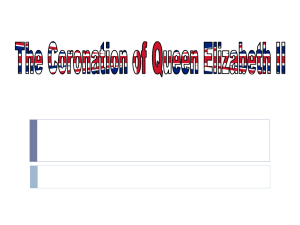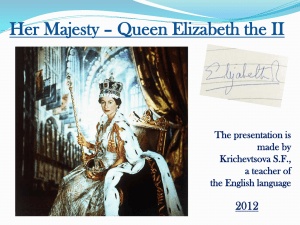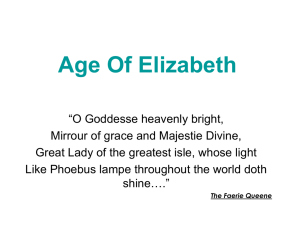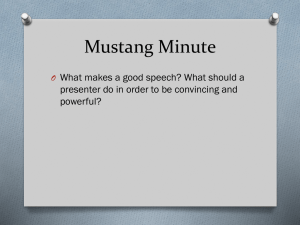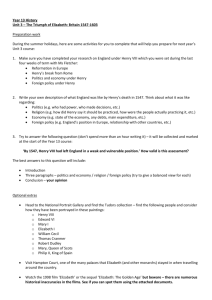Sanchez Julissa Sanchez English II Pre
advertisement
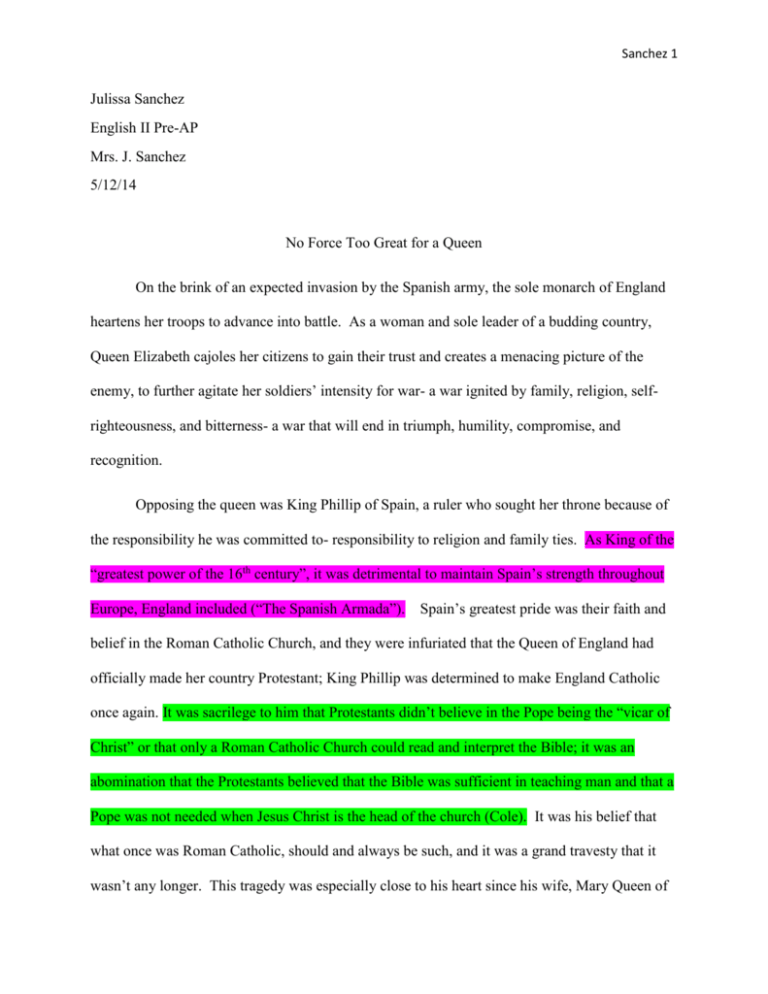
Sanchez 1 Julissa Sanchez English II Pre-AP Mrs. J. Sanchez 5/12/14 No Force Too Great for a Queen On the brink of an expected invasion by the Spanish army, the sole monarch of England heartens her troops to advance into battle. As a woman and sole leader of a budding country, Queen Elizabeth cajoles her citizens to gain their trust and creates a menacing picture of the enemy, to further agitate her soldiers’ intensity for war- a war ignited by family, religion, selfrighteousness, and bitterness- a war that will end in triumph, humility, compromise, and recognition. Opposing the queen was King Phillip of Spain, a ruler who sought her throne because of the responsibility he was committed to- responsibility to religion and family ties. As King of the “greatest power of the 16th century”, it was detrimental to maintain Spain’s strength throughout Europe, England included (“The Spanish Armada”). Spain’s greatest pride was their faith and belief in the Roman Catholic Church, and they were infuriated that the Queen of England had officially made her country Protestant; King Phillip was determined to make England Catholic once again. It was sacrilege to him that Protestants didn’t believe in the Pope being the “vicar of Christ” or that only a Roman Catholic Church could read and interpret the Bible; it was an abomination that the Protestants believed that the Bible was sufficient in teaching man and that a Pope was not needed when Jesus Christ is the head of the church (Cole). It was his belief that what once was Roman Catholic, should and always be such, and it was a grand travesty that it wasn’t any longer. This tragedy was especially close to his heart since his wife, Mary Queen of Sanchez 2 Scots, a devout Catholic and heir to the throne, was removed from its power for her zealous and rigid ways and ultimately imprisoned. It was during this time that King Phillip began initiating the “Empresa de Inglatera (Enterprise of England)” to overthrow the Protestant regime, an initiation whose schemes dated back to 1559, twenty-nine years before his actual attack (Adams). His plan was to liberate Mary and reinstate her power to the throne, but when she was executed for treason against the queen, her half-sister Elizabeth I, it was then that he redirected his intentions. He would invade and take the throne from Queen Elizabeth I and offer it to his daughter the “Infante Isabella” (“The Spanish Armada”). It was never his intention to allow Elizabeth to claim the throne due to his belief, as well as Spain as a whole, that she was “illegitimate”(“The Spanish Armada”). Mary was the first heir and child of the past king, King Henry VIII, with his first wife that he divorced. Elizabeth was the second heir and daughter of the king with his second wife, a wife that the Roman Catholic Church did not consent for him to marry, therefore damning Elizabeth as a bastard child, illegitimate, and one unfit and rejected by Roman Catholics in Spain to be queen. To show a sense of compromise, King Phillip even proposed marriage between the two so that he could regain the throne (since his wife lost it), but the valiant and independent Queen refused such an idea (Adams). It was settled, the only thing that King Phillip could do was threaten her with war and wage war upon her to gain what he felt compelled to restore. Waging war with such a queen should have be a threat in itself, for Queen Elizabeth I it seems was born to lead and fight against any forms of tyranny that threatened her country. She “inherited intelligence, determination, and shrewdness” from her father King Henry VIII and mother Anne Boleyn (“Elizabeth I”). It was by these attributes that she was able to rule with an iron fist in a velvet glove, even to the point of remaining single her entire life. The Queen Sanchez 3 concluded herself to be married to England, never accepting marriage proposals from any prince or duke in Europe; she was fully aware of the intentions of such men, who were more than likely more interested in her throne and power, than her heart. After being coronated as Queen of England, after her half-sister Mary’s treacherous and short-lived reign, she seemed to have known of the great responsibility before her to bring England up to the ranks of even the greatest, most powerful and wealthy country like Spain. She would be strong and she would be faithful to God. Unlike her greatest adversary Spain, the Queen believed differently from the Roman Catholics and would proclaim, “There is only one Jesus Christ and all the rest is dispute over trifles” (“Elizabeth I”). Instead of waging war against other religions, she focused on building the esteem of her country. And it was at the banks of Tilbury that she met man-to-man with her troops atop a white horse “like a true warrior”, as was her majesty’s normal fashion, to have them rise and defeat the enemy- Spain (“The Spanish Armada”). It was here on the banks of Tilbury that she would test their esteem and capability against the number one strength in the world. In her speech, the queen thrived on the use of diction to motivate her men to go into battle and to solidify their belief that war was necessary to deflect the fatal harm that would be brought on by the enemy. She begins her speech by referring to her fighting citizens as “loving people” who must “commit themselves to England by defending it from “treachery” (Tudor). Approaching them on a personal and thoughtful level, she urges them to unite as one to defend England at all costs. This commitment is necessary in order to assure that Spain’s evil does not come to harm the innocent. She continues to pass on an urgency to fight back by saying the enemies are “tyrants” who “dare to invade” the borders of her “realm” (Tudor). Spain is given an image of monsters that will pillage and violate the citizens of England, turning their perfect Sanchez 4 country of tranquility into a hellish pandemonium. A terrible image of the enemy such as this would magnify the soldiers’ intensity to defend England, but not just for the country as a power, but for the protection of their own homes and families. To put aside any doubt or fear that may be conflicting her pawns, she remind them of the “virtue, “valor”, and “victory” for “God” that shall await them in the end (Tudor). Battle becomes a competition for glory and honor that transcends any golden trophy, which would make their sacrifice honorable and righteous and holy. Those who may suffer or die in battle will know that their legacy will go on and that they made the ultimate sacrifice for the security and peace of their nation. Although a woman handing down the commands of war to her men, she does so full-heartedly and with great strength. Using her iron fists and velvet gloves, the queen of England pushes and inspires her men to take on the challenge of defending what is righteous against that which is baneful. And to Spain’s surprise, she did. Some believe it was God working on their side, but nonetheless, the queen of a small and unwealthy country was triumphant over the largest and wealthiest country in the world. Despite it being very costly and putting England in a tad of an economical depression, England held a thanksgiving service at St. Paul’s Cathedral for deliverance (“Elizabeth I”, “The Spanish Armada”). The Queen wanted to personally thank God for their victory, which was partially due to the storms that buffeted and worked against the armada, giving England more time to prepare and the advantage to attack! She believed the storm to be the work of a Protestant God and exclaimed, “God bless you my people!” where upon her loyal subjects called out a thousand blessings upon her (“The Spanish Armada”). For Spain, the “failure of the Armada shattered the image of the invincibility of Spanish arms”, and many Spaniards never saw home again (Adams, “The Spanish Armada”). Sanchez 5 Indeed it was England’s day and the day evolved into one of the greatest countries in the world. Queen Elizabeth I, as the last Tudor and with her country’s pride her strength, moved forward to make her 45 year reign the “most glorious in English history” (“Elizabeth I”). She established the Protestant Church of England and established a compromise between Roman Catholics and Protestants, probably saving England from future religious wars (“Elizabeth I”). She graciously invited the Golden Age to prosper with art, music, poetry, drama, and introduced the world and future to William Shakespeare. She, Queen Elizabeth I, was one of the world’s greatest leaders. Riding on a white horse, when most queens would be carried in a carriage, she showed the world, and those more powerful than she, that with passion, a sense of purpose, a bending to God’s will, and a “heart and stomach of a King”, anyone, even a mere woman, could bestride giants in one’s life to mere conquests. Sanchez 6 Works Cited Page Adams, Simon. “The Spanish Armada.” BBC. 17 Feb. 2011. Web. 1 May 2014. Cole, Ethan. “What Divides Catholics and Protestants?” The Christian Post. 18 Apr. 2008. Web. 1 May 2014. “Elizabeth I”. The British Monarch. 2009. Web. 3 May 2014. “The Spanish Armada”. Elizabeth I. Web. 1 May 2014. Tudor, Elizabeth. “Speech to the Troops at Tilbury.” Luminarium. 2003. Web. 7 May 2014.

